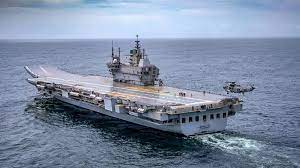NEW DELHI: The Defence Acquisition Council (DAC), the apex decision-making body of the Ministry of Defence, is all set to okay a Rs 40,000-crore project to indigenously make a second aircraft carrier, a replica of the existing INS Vikrant.
Sources in the Navy said the DAC was scheduled to give the green light to the project on November 30. The DAC is headed by Defence Minister Rajnath Singh.
The Navy was pushing for a bigger 70,000-tonne carrier, which has been put on hold. The case for having another carrier of the 45,000-tonne class — the same as INS Vikrant — has been okayed by the tri-services defence procurement board. INS Vikrant was commissioned into the Navy in September last year. It will have more or less the same design as that of INS Vikrant with technological upgrades expected over the next eight to 10 years. INS Vikrant was manufactured by Cochin Shipyard Limited at Kochi over 13 years at a cost of Rs 23,000 crore. However, now that expertise has been gained, the timeline for the next one could be seven to eight years. In the past few years, the Navy has adopted “integrated construction” that entails various parts of a ship, particularly its hull, superstructure and internal systems. These are manufactured in separate blocks, which are aligned seamlessly to create the ship’s structure.
In the past five years, new infrastructure has been added at shipyards, supply lines established and artificial intelligence applied to arrive at “sequencing” of putting together a warship, including sourcing of material and production timelines.
A key element of an aircraft carrier is the launch mechanism technology it uses to allow a fighter jet to take off and land on its deck. The Navy plans to stick to the short take-off but arrested recovery (STOBAR) technique. Indian carriers, INS Vikramaditya and INS Vikrant, both use the STOBAR technology.
Sources said a delay in getting on with the next carrier could jeopardise the hard-earned skill of making such warships. The private industry, makers of specialised steel, suppliers of pneumatics, wires, cables and several parts, all had acquired skills during the making of INS Vikrant.
India is racing to match China’s naval strength that has two operational aircraft carriers –Liaoning and Shandong. In July this year, it launched another one, Fujian, expected to be commissioned in 2025.


